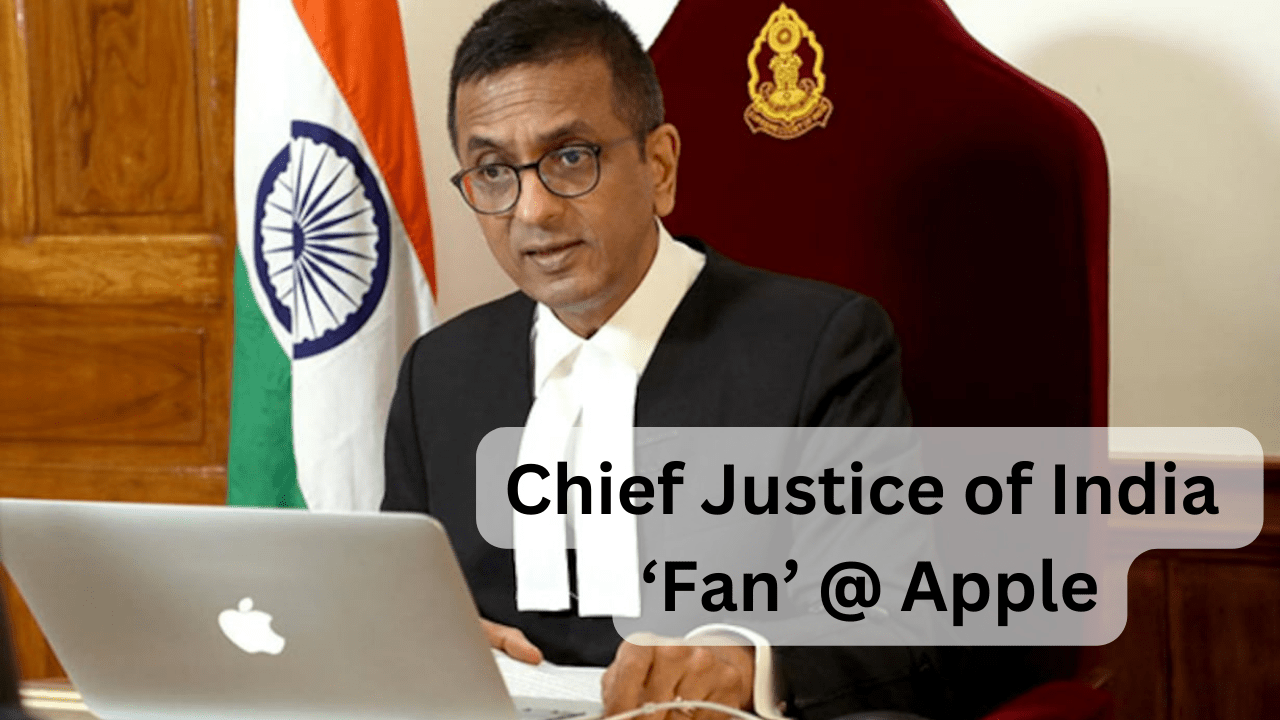Chief Justice D Y Chandrachud: Imagine this: You’re watching a live stream of a Supreme Court hearing, and suddenly, “AirDrop” flashes across the screen. Sounds outlandish, right? Not anymore! Under the leadership of Chief Justice of India D.Y. Chandrachud, the Supreme Court is embracing technology like never before, transforming Courtroom No. 1 into a tech-savvy haven.

Embracing Technology in the Highest Court
Gone are the days of traditional courtrooms with piles of paperwork and voluminous law books. In Court Number 1, where CJI Chandrachud presides, the familiar sound of AirDrop is becoming commonplace. The use of iPads and AirDrop for sharing documents has become integral to the court proceedings, reflecting a judiciary that is not only keeping pace with technology but also setting new standards.
CJI Chandrachud, a true advocate of technology, extends his motivation beyond fellow judges to senior advocates as well. Recognizing the importance of a smooth functioning legal system, he encourages the adoption of technology among legal practitioners.
- Paperless appearances: Lawyers register their presence electronically, saving countless trees.
- Internal email communication: Streamlining official communication within the Court.
- Digital entry passes: Replacing paper passes with convenient online access.
- RTI portal: Making Right to Information requests entirely paperless.
The iPad Revolution in Legal Discourse
Senior advocates, including luminaries like Attorney General R Venkatramani, Solicitor General Tushar Mehta, Kapil Sibal, Abhishek Manu Singhvi, and others, have embraced this tech-forward approach. iPads have become their preferred tools for referencing arguments and presenting documents in Court Number 1. This shift marks a significant departure from traditional methods and showcases the legal fraternity’s readiness to evolve with the times.
Rise of ADAS in India: Unexpected Surge in Demand Shapes the Future of Autonomous Driving- Explained
Towards a Paperless Judiciary
CJI Chandrachud’s vision extends beyond mere convenience. He emphasizes the need for a paperless courtroom, aligning with global efforts to reduce environmental impact. By urging the use of iPads and AirDrop, Court Number 1 is making strides toward operating in a paperless mode. This not only saves countless trees from being felled but also contributes to a more eco-friendly judicial system.
In a bid to further the cause of environmental sustainability, CJI Chandrachud introduced a paperless method for recording lawyers’ appearances in cases. Additionally, a new email policy for internal communication has been implemented, reducing the reliance on paper documentation within the court’s administrative processes. Even entry passes to the Supreme Court and the RTI portal have undergone a complete transition to a paperless format.
Tech-Friendly Courtrooms: A Glimpse into the Future
The courtroom’s physical landscape is evolving with technology. Smart pop-up screens adorn the judges’ dias, facilitating efficient document reading. The cumbersome law books that once lined courtroom shelves have been replaced by a digital library, making legal resources more accessible and reducing physical clutter.
To facilitate seamless video conferencing, a massive 120-inch screen has been installed on one of the courtroom walls. This technological enhancement not only streamlines communication but also enhances the overall courtroom experience.
Moreover, state-of-the-art tools are in use to transcribe oral arguments instantly, ensuring an accurate record of proceedings and facilitating more efficient case management.
The Supreme Court’s Foray into Digital Broadcasting
Taking a giant leap into the digital realm, the Supreme Court is gearing up to launch its own Over-The-Top (OTT) platform for live streaming constitutional bench hearings. While the court already live streams such cases on platforms like YouTube and NIC, this dedicated platform signifies a commitment to expanding digital accessibility.
Despite potential challenges in infrastructure and bandwidth for widespread streaming, CJI Chandrachud is actively working towards making this vision a reality. The success of live streaming constitutional bench cases on YouTube and NIC, with as many as 8 lakh viewers on the first day, underscores the public’s interest in transparent and accessible legal proceedings.
Tech-Savvy Courtroom Enhancements:
- Smart pop-up screens: Judges have instant access to documents right at their fingertips.
- Digital library: Physical law books have been replaced with readily accessible digital resources.
- 120-inch video conferencing screen: Seamless virtual collaboration with remote participants.
- Real-time transcription: Oral arguments are instantly converted into text for easy referencing.
The Impact of Tech Transformation:
- Environmental benefits: The paperless push conserves precious resources and protects the environment.
- Increased efficiency: Technology streamlines processes, saving time and effort for all stakeholders.
- Enhanced transparency: Public access to Court proceedings fosters greater understanding and accountability.
A Digital Metamorphosis in Indian Judiciary
The digital revolution led by CJI D Y Chandrachud in Court Number 1 is emblematic of a forward-looking judiciary embracing technology for efficiency, sustainability, and accessibility. The confluence of iPads, AirDrop, paperless initiatives, and live streaming platforms marks a watershed moment in the history of India’s Supreme Court. As the legal fraternity navigates this digital metamorphosis, Court Number 1 stands as a beacon of innovation, setting the stage for a tech-driven future in Indian jurisprudence.